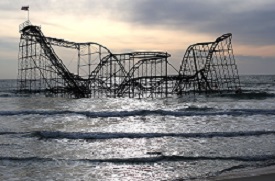Sustainability and Resilience: Making the Connection
When most people consider “resilience,” they think about bouncing back from some sort of unwelcome catastrophe. Whether it’s “super storms” devastating coastal communities and disrupting millions of people along the east coast, wildfires in the mountain and western states, or natural disasters and related, human-caused emergencies such as the tsunami and Fukushima meltdown, recent events have magnified the importance of being prepared to ride out hard times.
For many, that has meant storing caches of nonperishable food, water supplies, and plenty of extra batteries. An emergency plan and meeting spot for all family members is also a great idea. But what is the best way to define resiliency for society as a whole? Can we incorporate actions into plans that not only make our communities more resilient to future catastrophes, but make us more prosperous and healthy now?
My colleagues and I at EPA have been exploring ongoing research to consider resiliency in a broader context, linking it with programs that help us and our partners identify challenges and advance a more sustainable future.
In January of 2013 EPA in cooperation with the National Science Foundation, the National Council for Science and Environment, and Dow Chemical hosted a workshop on resilience and sustainability. Papers from this workshop are now highlighted in a special issue of the Solutions Journal.
In a featured paper in this issue: Resilience: Navigating toward a Sustainable Future, we share what we have learned and offer a new, forward thinking definition of resilience for communities, companies, and others to consider and strive for: “the capacity for a system to survive, adapt, and flourish in the face of turbulent change and uncertainty.” Along with my co-authors Joseph Fiksel (who also served as the journal’s guest editor) and Iris Goodman, we explore a variety of solutions for strengthening both resilience and sustainability in urban communities and industrial enterprises.
We are not alone. The concept of resilience and its relationship to sustainability is now attracting a great deal of attention:
- EPA is looking at research tools and approaches that address and advance community resilience and climate adaptation.
- Policy makers, business executives, and community leaders are incorporating resilience into their planning operations.
- Major companies are systematically strengthening the resilience of their global supply chains.
- A network of urban planners, architects, designers, engineers, and landscape architects are developing creative and practical strategies to increase the resilience of cities.
These and many other leading organizations are taking steps today to prepare for the next “super storm” threatening their operations, while helping us find ways to achieve a sustainable future for us all. Read more about how leading government, non-government and business organizations are working toward a sustainable future in the face of climate change and global urbanization: Resilience: Navigating toward a Sustainable Future.
About the Author: A leader in sustainability research, Alan Hecht, Ph.D. is the Director for Sustainable Development in EPA’s Office of Research and Development.



Oct 24, 2014 @ 17:47:20
Making the Connection : Universe……..
I assume on the next millennium many people should stay in another planet which spread as farmstead like here long ago. Nowadays urban concept is receipting, but not wrong we learn back our old designed to anticipate our journey : ~subjugate the universe~.-